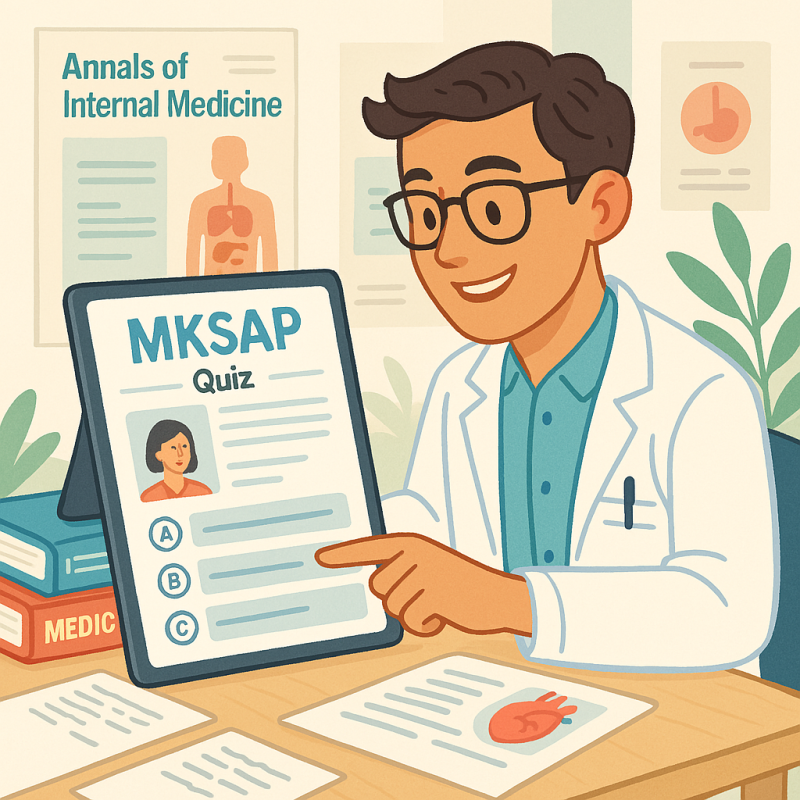Case 21-2025: A 75-Year-Old Man with Cough, Dyspnea, and Hypoxemia
表題の論文 をAIとともに読み込みました(本記事は元文献を見ながら読んでいただく前提ですので、詳細な病歴、画像や臨床検査所見等は元文献をご参照ください)
1. どんなもの?
本論文は、咳、呼吸困難、および低酸素血症を呈する75歳の男性の症例を報告しています。患者は、既存の重症喘息とアレルギー性気管支肺アスペルギルス症(ABPA)の病歴があり、グルココルチコイドを長期にわたって使用していました。入院時のCT画像検査では、右肺上葉に空洞性病変、両下葉に腫瘤様浸潤影が認められました。臨床経過と検査結果から、ノカルジア・ファーシニカ複合体と非結核性抗酸菌(NTM)であるマイコバクテリウム・アブセッサス複合体による混合感染が最終的な診断として確定されました。この症例は、免疫抑制状態にある患者における日和見感染症の診断の複雑さと、多剤併用療法および長期治療の必要性を示しています。特に、ノカルジアとマイコバクテリウムの同時感染という稀なケースであり、培養条件の工夫によって初めて両方の病原体が特定された点が技術的新規性として挙げられます。想定されるユースケースは、免疫不全患者における原因不明の肺病変に対する鑑別診断と治療戦略の確立です。本研究は、まれな混合感染症の診断と治療に関する知見を提供し、特にグルココルチコイド長期使用者における日和見感染症の可能性を強調しています。
2. どうやって診断した?
本症例は、臨床症状、画像所見、および微生物学的検査に基づいて診断されました。
初期評価と画像診断 : 患者は進行性の呼吸困難、咳、低酸素血症で入院しました。 胸部X線写真では左肺底部に浸潤影、右肺に空気腔浸潤影が認められました。 胸部CTでは、左下葉を中心に舌区および左上葉後上区域に及ぶ腫瘤様浸潤影と気管支の不透明化、末梢のすりガラス陰影が確認されました。また、右下葉にも別の腫瘤様浸潤影と、周囲にすりガラス陰影を伴う複数の充実性結節、右肺上葉後区域には直径3.2 cmの空洞性腫瘤が認められました。 これらの画像所見は、炎症性疾患、癌、感染症の可能性を示唆しました。 微生物学的検査 :
グラム染色 : 喀痰のグラム染色では、フィラメント状、分岐状、ビーズ状のグラム陽性桿菌が認められました。これは特にノカルジア属の特徴でした。 変法抗酸菌染色 : 喀痰の変法抗酸菌染色では、ノカルジアと一致する赤ピンク色の微生物が確認されました。これはミコール酸を少量産生するノカルジアと、ミコール酸を産生しないアクチノミセスを鑑別するのに役立ちました。 オーラミン-ローダミン蛍光染色 : 喀痰のオーラミン-ローダミン蛍光染色では、短い抗酸菌が検出され、マイコバクテリアとの混合感染が示唆されました。 培養 :
通常の培養では8日間の培養後、ワックス状の黄色コロニーが純粋培養され、質量分析によりNocardia farcinica 複合体と同定されました。
ノカルジアの増殖を抑制するためにシュウ酸で処理した喀痰サンプルを7日間培養したところ、乾燥した白色コロニーが純粋培養され、質量分析によりM. abscessus 複合体と同定されました。
病理組織学的検査 : 経気管支生検の組織のグロコットメセナミン銀染色では、約1ミクロン幅のフィラメント状、分岐状の微生物の浸潤が確認され、ノカルジア感染と一致しました。 抗酸菌染色は陰性でした。 治療への反応 : 患者は、ノカルジア症に対する治療として、静脈内トリメトプリム-スルファメトキサゾールとイミペネムの併用療法を開始しました。 その後、呼吸困難と低酸素血症は改善し、酸素飽和度も改善しました。 治療3ヶ月後の胸部CTでは、以前認められた多発性浸潤影がほぼ消失し、胸水も解消していました。 これらの治療への良好な反応が、診断の正当性をさらに裏付けました。
以上の多角的な検査と治療への反応により、本症例における
Nocardia farcinica 複合体とMycobacterium abscessus 複合体の混合感染と診断されました。
3. どうすごい?
稀な混合感染症の特定 : ノカルジア症と非結核性抗酸菌(NTM)感染症の混合感染は稀であり、特にグルココルチコイド長期使用者という免疫抑制状態の患者で同時に発症したケースは、鑑別診断の難しさを示しています。本症例では、通常の喀痰培養ではノカルジアが優勢に増殖し、NTMが検出されない可能性がありましたが、ノカルジアの増殖を抑制する特殊処理(シュウ酸処理)を行うことで、初めてM. abscessus 複合体の存在を明らかにしました。 この診断手法は、これまでのルーチンな検査では見過ごされていた可能性のある混合感染症の特定に新たな道を開くものです。診断的アプローチの精緻化 : グラム染色、変法抗酸菌染色、オーラミン-ローダミン蛍光染色、そして特異的な培養条件を組み合わせることで、形態学的に類似するが治療法が異なる複数の微生物を正確に鑑別しました。 これは、複雑な肺病変を持つ免疫不全患者に対する診断的ワークフローにおいて重要な示唆を与えます。治療戦略への示唆 : ノカルジア症とNTM感染症は異なる治療レジメンを必要としますが、両方の病原体を特定することで、それぞれの感染症に効果的な抗菌薬を慎重に選択し、不適切な単剤療法を避けることができました。 このアプローチは、薬剤耐性菌の出現を防ぎ、治療効果を最大化するために極めて重要です。特に、広範な肺病変や播種性疾患の場合、静脈内抗菌薬の併用療法が推奨されるノカルジア症の治療を適切に行えたことは、患者の予後改善に直結しました。 臨床的意義 : グルココルチコイドの長期使用は、ノカルジア感染症に対する感受性を高めることが知られていますが 、本症例は、そのリスクがNTMのような他の日和見病原体との同時感染につながる可能性を示唆しています。これは、免疫抑制患者の管理において、より広範な鑑別診断と病原体スクリーニングの重要性を強調しています。
4. 議論はある?
本研究にはいくつかの議論点と未解決の課題が存在します。
診断的サンプリングの限界 : 本症例では喀痰と経気管支生検組織から病原体が検出されましたが、特に重症患者の場合、より侵襲的な生検(例:外科的肺生検)が必要となることもあります。喀痰サンプルの処理方法(ノカルジアの増殖を抑制する目的でのシュウ酸処理)は革新的でしたが、すべてのケースで同様に有効かどうかはさらなる検証が必要です。 マイコバクテリウム・アブセッサス複合体の臨床的意義 : 喀痰からM. abscessus 複合体が検出されたものの、初期治療はノカルジア感染に焦点を当て、M. abscessus 感染に対する治療は臨床反応を見て決定する計画でした。 NTMは肺に定着するだけで病原性を示さない場合があるため、真の感染と定着の区別は常に課題となります。 本症例では、M. abscessus が臨床症状にどの程度寄与していたのか、またノカルジア治療によってM. abscessus が部分的に抑制された可能性についても議論の余地があります。治療期間と再発リスク : ノカルジア症の治療は、再発のリスクが高いため、長期間にわたることが一般的です(孤立性肺ノカルジア症で6~12ヶ月、播種性疾患で少なくとも12ヶ月)。 本症例では12ヶ月間の経口トリメトプリム-スルファメトキサゾール療法が計画されましたが、長期的な治療遵守と再発率に関するデータは提示されていません。 混合感染の場合、治療期間の決定はさらに複雑になります。薬剤耐性の可能性 : ノカルジア種間および地域間で薬剤耐性にばらつきがあるため、感受性試験に基づいた抗菌薬選択が重要です。 M. abscessus もまた、多剤耐性を示すことがあり、治療選択を複雑にする可能性があります。 本症例で選択された治療薬に対する両病原体の感受性プロファイルに関する詳細なデータは提供されていません。一般化可能性 : 本論文は1つの症例報告であり、その結果を他の患者集団に一般化する際には注意が必要です。ただし、稀な混合感染症の診断と治療に関する重要な示唆を提供しています。潜在的な倫理的考慮事項 : 患者のプライバシーは保護されていますが、稀な症例であるため、詳細な病歴や画像情報が患者識別のリスクをもたらす可能性も考慮すべきです。
5. 技術や手法のキモはどこ?
本症例における技術や手法のキモは、稀な混合感染症を正確に診断するために、標準的な微生物学的検査に加えて、特定の微生物の増殖特性を考慮した培養方法を組み合わせた点にあります。
微生物学的検査の段階的アプローチ :
グラム染色と変法抗酸菌染色 : 患者の喀痰からグラム陽性桿菌が検出された時点で、ノカルジアとアクチノミセスという形態学的に類似した2つの病原体が鑑別診断に挙がりました。ここで、変法抗酸菌染色を用いて、ノカルジアが産生する微量のミコール酸を利用し、赤ピンク色に染色されるノカルジアと、染色されないアクチノミセスを鑑別した点が重要です。 これは迅速な鑑別診断に貢献しました。オーラミン-ローダミン蛍光染色 : 予想外に短い抗酸菌が検出されたことで、ノカルジアとは異なるマイコバクテリアの存在が強く示唆されました。 この時点で、単一の感染症ではなく混合感染の可能性が浮上しました。
選択的培養による病原体分離 :
通常培養と脱汚染処理 : ノカルジアやマイコバクテリアは、一般的な細菌よりも増殖が遅く、通常の細菌叢によって容易に増殖が阻害されるという特性があります。このため、喀痰などの非無菌検体は、通常の細菌の増殖を抑えるために水酸化ナトリウムで脱汚染処理されます。 これにより、Nocardia farcinica 複合体が純粋培養で得られました。 ノカルジア抑制培養 : 最も重要な技術的ブレークスルーは、ノカルジアがマイコバクテリアの増殖を抑制する可能性を考慮し、シュウ酸というより強力な処理でノカルジアを殺菌した上で喀痰を培養した点です。 この工夫により、Mycobacterium abscessus 複合体が純粋培養で得られました。 この手法がなければ、M. abscessus 感染は見過ごされていた可能性が高く、正確な診断と適切な治療の機会を逸していたでしょう。
治療戦略への応用 : 両方の病原体を特定したことで、それぞれの感受性プロファイルを考慮し、トリメトプリム-スルファメトキサゾールとイミペネムという併用療法を選択できました。 この併用療法は、ノカルジア症の重症例に推奨されるものであり 、M. abscessus に対しても部分的に有効である可能性を考慮することで、不適切な単剤療法を避け、耐性菌の出現リスクを低減しました。
これらの診断手法の組み合わせ、特にノカルジアの増殖を抑制する特定の培養条件を用いるという着想が、本症例の正確な診断と治療に不可欠な技術的キモであり、他の複雑な混合感染症の診断にも応用可能な知見を提供しています。
6. 次に読むべき論文は?
本研究の文脈をさらに深く理解し、関連する研究領域の最新動向を把握するためには、以下の論文が推奨されます。
ノカルジア症に関する総説 :
Wilson, J. W. (2012). “Nocardiosis: updates and clinical overview.” Mayo Clinic Proceedings , 87(4), 403-407.
ノカルジア症の診断、治療、疫学に関する包括的なレビューであり、本症例の背景知識を深めるのに役立ちます。特に、免疫不全患者におけるノカルジア感染症の臨床像について理解を深めることができます。
Traxler, R. M., Bell, M. E., Lasker, B., Headd, B., Shieh, W.-J., & McQuiston, J. R. (2022). “Updated Review on Nocardia Species: 2006-2021.” Clinical Microbiology Reviews , 35(4), e00027-21.
ノカルジア属の最新の分類、病原性、診断、治療に関する包括的なレビューです。近年発見された新しいノカルジア種や、薬剤感受性のトレンドについても言及がある可能性があり、より詳細な情報を得られます。
非結核性抗酸菌(NTM)肺疾患の診断と治療ガイドライン :
Daley, C. L., Iaccarino, J. M., Lange, C., et al. (2020). “Treatment of Nontuberculous Mycobacterial Pulmonary Disease: An Official ATS/ERS/ESCMID/IDSA Clinical Practice Guideline.” Clinical Infectious Diseases , 71(4), e1-e36.
NTM肺疾患の診断基準、治療アルゴリズム、薬剤感受性検査の重要性など、臨床医がNTM感染症を管理するための詳細な指針が示されています。本症例におけるM. abscessus 複合体の臨床的意義と治療方針を理解する上で不可欠です。
免疫不全患者における日和見感染症 :
この分野の一般的なレビュー論文や、特定の免疫抑制状態(例:長期グルココルチコイド使用、生物学的製剤の使用)における感染症リスクに関する論文を読むことで、本症例の患者背景をより深く理解できます。 dupilumabの使用が寄生虫感染症への感受性を高める可能性についても言及されていますが 、他の免疫抑制剤が引き起こす日和見感染症全般について学ぶことは、鑑別診断能力の向上に繋がります。
肺の空洞性病変と腫瘤性病変の画像診断 :
Duong, T. B., Ceglar, S., Reaume, M., & Lee, C. (2020). “Imaging Approach to Cavitary Lung Disease.” Annals of the American Thoracic Society , 17(3), 367-371.
Kanne, J. P., Yandow, D. R., Mohammed, T. L., & Meyer, C. A. (2011). “CT findings of pulmonary nocardiosis.” AJR American Journal of Roentgenology , 197(2), W266-W272.
これらの論文は、肺の空洞性病変や腫瘤性病変の鑑別診断に役立つ画像所見に焦点を当てています。ノカルジア症のCT所見に関する詳細は、診断推論の過程を理解する上で有益です。
Podcast: Play in new window | Download





